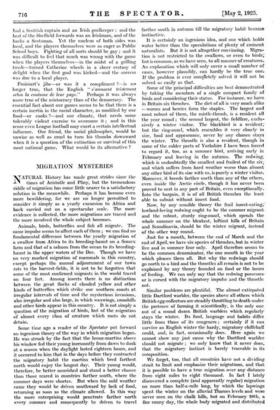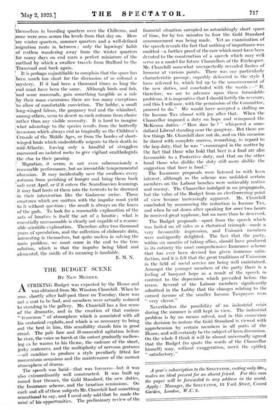MIGRATION MYSTERIES
NATURAL History has made great strides since the times of Aristotle and Pliny, but the tremendous riddle of migration has come little nearer to a satisfactory solution in the meanwhile. Perhaps it has become even more bewildering, for we are no longer permitted to consider it simply as a yearly excursion to Africa and back carried out on a spectacular scale. The more evidence is collected, the more migrations are traced and the more involved the whole subject becomes.
Animals, birds, butterflies and fish all migrate. The same impulse seems to affect each of them ; we can find no fundamental difference between the yearly migration of a swallow from Africa to its breeding-haunt on a Sussex farm and that of a salmon from the ocean to its breeding- haunt in the upper waters of the Dee. Though we have no very marked migration of mammals in this country, except perhaps the annual adjournment of our town rats to the harvest-fields, it is not to be forgotten that some of the most confirmed migrants in the world travel on four feet. Among insects there is no distinction between the great flocks of clouded yellow and other kinds of butterflies which strike our southern coasts at irregular intervals of time and the mysterious invasions, also irregular and also large, in which waxwings, crossbills and other birds appear in this country. It is not simply a question of the migration of birds, but of the migration of almost every class of creature which roots do not detain.
Some time ago a reader of the Spectator put forward an ingenious theory of the way in which migration began. He was struck by the fact that the house-martins above his window fed their young incessantly from dawn to dusk at a season when the daylight lasted eighteen hours, and it occurred to him that in the days before they contracted the migratory habit the martins which bred farthest north would enjoy the longest day. Their young would, therefore, be better nourished and stand a better chance than those reared in countries farther south, where the summer days were shorter. But when the cold weather came they would be driven southward by lack of food, returning as soon as the climate allowed. In this way the more enterprising would penetrate farther north every summer and consequently be driven to travel farther south in autumn till the migratory habit became' instinctive.
It is certainly an ingenious idea, and one which holds water better than the speculations of plenty of eminent naturalists. But it is not altogether convincing. Migra- tion is not restricted to the swallows, or even to birds; but is common, as we have seen, to all manner of creatures.
An explanation which will only cover a small number of cases, however plausibly, can hardly be the true one: If the problem is ever completely solved it will not be solved so easily as that.
Some of the principal difficulties are best demonstrated by taking the members of a single compact family of birds and considering their status. For instance, we have in Britain six thrushes. The diet of all is very much alike —worms and berries form the staples. The largest and most robust of them, the mistle-thrush, is a resident all the year round ; the second largest, the fieldfare, exclu- sively a winter visitor. The blackbird is a resident; but the ring-ouzel, which resembles it very closely in size, food and appearance, never by any chance stays the winter. The throstle is also a resident, though in some of the colder parts of Yorkshire I have been forced to regard it, too, as a summer bird, arriving early in February and leaving in the autumn. The redwing; which is undoubtedly the smallest and frailest of the six; and which suffers from hard weather worse than almost any other bird of its size with us, is purely a winter visitor.
Moreover, it breeds farther north than any of the others, even inside the Arctic circle, though it has never been proved to nest in any part of Britain, even exceptionally.. Into the bargain, it is of all British thrushes the least able to subsist without insect food.
Now, by any sensible theory the frail insect-eating;i lowland-loving redwing ought to be the summer migrant- and the robust, sturdy ring-ouzel, which spends the whole summer on the bleakest, loftiest hills of Britain and Scandinavia, should be the winter migrant, instead of the other way round.
Just for a month, between the end of March and the end of April, we have six species of thrushes, but in winter five and in summer four only. April therefore seems to be the common denominator, the one month in the year which pleases them all. But why the redwings should go north to a bird and the throstles all remain is not to be explained by any theory founded on food or the hours of feeding. We can only say that the redwing possesses. or is cursed with the migratory impulse and the throstle not.
Similar problems are plentiful. The almost extirpated little Dartford warbler, the species above all others which British egg-collectors are steadily throttling to death under the pretence of farming it scientifically, is the only one out of a round dozen British warblers which regularly stays the winter. Its food, language and habits differ little from those of its congeners ; certainly if it can survive an English winter the hardy, migratory chiffchaff could, and, in fact, occasionally does. Here again we cannot show any just cause why the Dartford warbler should not migrate ; we only know that it never does, that the migratory instinct is barely traceable in its composition.
We forget, too, that all countries have not a dividing strait to limit and emphasize their migrations, and that it is possible to have a true migration over any distance from eight miles to eight thousand. In fact I lately discovered a complete (and apparently regular) migration no more than half-a-mile long, by which the lapwings spent the winter on the alluvial Thames levels and were never seen on the chalk hills, but on February 28th,. a fine sunny day, the whole body migrated and distributed themselves in breeding quarters over the Chilterns, and ,...none were seen across the levels from that day on. Here 1'are winter quarters, summer quarters and a well-defined migration route in between ; only the lapwings' habit of restless wandering away from the winter quarters for many clays on end mars a perfect miniature of the !method by which a swallow travels from Stafford to the !Transvaal and back again. It is perhaps unjustifiable to complain that the space has lbeen much too short for the discussion of so colossal a !mystery. If it had been a thousand times as long the end must have been the same. Although birds and fish, and some mammals, gain something tangible as a rule !by their mass excursions there are too many exceptions Ito allow of comfortable conviction. The hobby, a small (long-winged falcon, the garganey teal and the whimbrel, among others, seem to desert us each autumn from choice ;rather than any visible necessity. It is hard to imagine what advantage to the species results from the butterfly invasions which always end as tragically as the Children's Crusade of the Middle Ages, or from the hordes of short- winged birds which undoubtedly migrate to their death in .mid-Atlantic, leaving only a handful of stragglers marooned on isolated rocks to give vigilant ornithologists the clue to their passing.
Migration, it seems, is not even subconsciously a reasonable performance, but an irresistible temperamental obsession. It may incidentally save the swallows every autumn from perishing of hunger and bring them back safe next April, or if it enters the Scandinavian lemmings it may hurl hosts of them into the torrents to be drowned in their intoxication like the Gadarene swine. Those creatures which are smitten with the impulse must yield to it without question ; the result is always on the knees of the gods. To look for a reasonable explanation of the acts of lunatics is itself the act of a lunatic ; what is essentially unreasonable is clearly not capable of a reason- : able scientific explanation. Therefore after two thousand years of speculation, and the collection of elaborate data, interesting in themselves, but quite useless in solving the .main problem, we must come in the end to the true solutiOn, which is that the impulse being blind and :elemental, the riddle of its meaning is insoluble.
E. M. N.











































 Previous page
Previous page